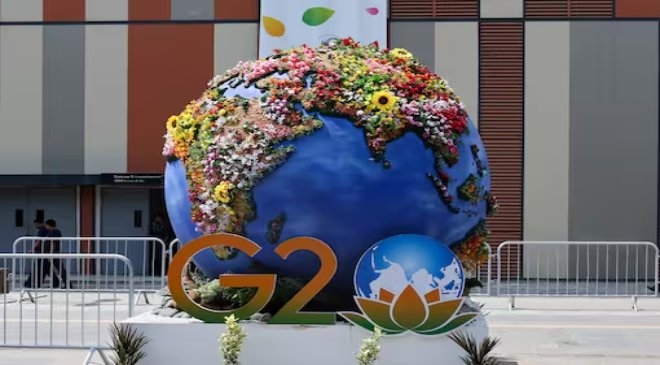The G20’s clear language on tripling renewable energy capacity could pave the way for countries to agree to this global goal at COP28, where they are expected to step up current NDCs and set higher targets for reducing emissions
The G20 summit in New Delhi has set the pace for enhanced climate action at COP28, as it refreshed its resolve to limit warming to 1.5 degrees Celsius as per the Paris Agreement. The high-profile event ended with a soft commitment from the world’s largest emitters to triple their renewable energy capacity by 2030.
The earth is already a degree warmer than before, and countries are required to step up their climate goals to protect the world from its devastating impact. The G20 Leaders Declaration urged countries to strengthen their 2030 targets in their nationally determined contributions (NDCs) by the end of the year taking into account different circumstances.
The 28th United Nations Climate Change conference will be held in the UAE in December, where all 196 countries that are signatories to the 2015 Paris Agreement will convene to take stock of the climate action so far. It will mark the first-ever ‘global stocktake’ – a process that will be conducted every five years to hold countries accountable for their efforts to reduce emissions. The COP28 has been pitched as the moment for course-correction.
Read More: Amit Shah-Led Parivartan Yatra in Chhattisgarh Signals Govt’s ‘Ability’ in Tackling Maoist Menace
NEED FOR AMBITIOUS CLIMATE ACTION
In its final declaration, the G20 strongly reiterated its resolve to limit warming to 1.5 degrees Celsius compared to pre-industrial levels, and agreed that current global ambitions were grossly insufficient to get on track with the Paris Agreement goals. It also took note of the finding of the Intergovernmental Panel on Climate Change (IPCC) that emissions must peak before 2025 for the world to meet its goal, but acknowledged that not all countries can achieve peak emissions within this period.
“Timeframes for peaking may be shaped by sustainable development, poverty eradication needs, equity, and in line with different national circumstances,” read the final statement, underscoring the principles of common but differentiated responsibilities (CBDR). Just and equitable energy transition is crucial for the Global South, a demand persistently raised by India in all the climate forums.
The G20 countries also agreed to contribute to a successful conclusion of the first global stocktake at COP28 in Dubai, which drives enhanced climate action across mitigation as well as adaptation. The grouping also reiterated its commitment to achieve global net zero greenhouse gas emissions, or carbon neutrality, by or around mid-century.
Read More: Nipah Alert in Kerala: All You Need to Know About the Virus, Symptoms, Precautions & Treatment
PUSH FOR TRIPLING RENEWABLE ENERGY CAPACITY BY 2030
According to experts, G20’s clear and concise language on tripling renewable energy (RE) capacity by 2030 can also increase the possibility that this goal can be agreed to at COP28. It also nudges countries to go back and reassess their own plans to ensure they are consistent with a tripling of global renewables, while taking into account the latest scientific developments and in line with different national circumstances.
“The inclusion of the statement on tripling renewable energy is the biggest win in the final declaration. We can build from here on till COP28 to improve on this language, (define targets, baseline and year) and it also forms hooks for countries to incorporate this into their NDC documents,” said Shruti Sharma, senior policy adviser, International Institute for Sustainable Development (IISD).
Read More: Nitin Gadkari proposes 10% hike in GST on diesel cars
CLIMATE FINANCE FOR DEVELOPING COUNTRIES
While the long-pending $100 billion every year is yet to be mobilised by developed countries, the G20 under India’s presidency managed to obtain a commitment from them on increasing low-cost financing for transition and this number has been stated at $4 billion per annum. The declaration noted the need of $5.8 trillion to $5.9 trillion in the pre-2030 period for developing countries to achieve their NDCs. However, the agreement is on facilitating finance and not its time-bound release.
India’s G20 presidency has continuously asserted that there was a need to change the language around climate finance from billions to trillions for people living in the Global South, which the declaration managed to achieve. The Leaders Declaration also included a pledge to increase the capacity of multilateral development banks (MDBs) to lend more and use existing funds better, and a number agreed on the funds required for energy transition.



































